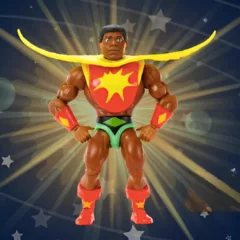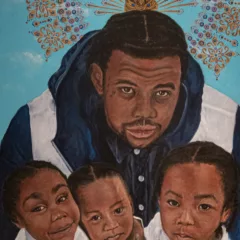Note: this article was written as part of Art Attack, the Philadelphia Daily News-Drexel University arts writing partnership, which recently ended before this story was published.
Born in China in 1941, artist Lily Yeh experienced first-hand the ravages of that country’s civil war when her family became refugees, fleeing to Taiwan as the communists took over. That personal story and the story of Yeh’s global art activism with communities from North Philadelphia to Rwanda and China is the subject of a new documentary film, The Barefoot Artist, now in post-production and ready for viewing later this year.
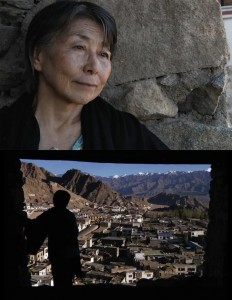
Co-directed by Yeh’s son, photographer and filmmaker Daniel Traub and filmmaker Glenn Holsten, the movie covers Yeh’s life and focuses in depth on her work in Philadelphia, where she created and ran the Village of Arts and Humanities from 1986-2004, bringing that North Philadelphia community together and planting the seed of hope through art.
I spoke by phone with Traub and Holsten in December when they were in the editing studio with editor Ann Tegnell, distilling some 80 hours of new and archival footage down into a 90-minute feature. The directors told me The Barefoot Artist came about when each of them was working on a separate film about Yeh, and they decided to pool their resources, energy and film footage and make one film jointly instead.
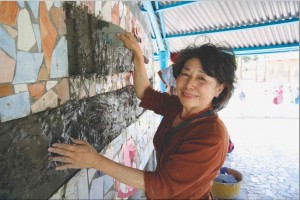
“It’s the two films together plus 15 years background in Lily’s life,” said Tegnell, hands on the computer doing the actual edits, with the two directors looking over her shoulder. If that seems stressful, not to worry. The three have worked together before and have an easy rapport and their trust in Tegnell is complete. “Editing is a delicious joy ride,” Holsten said laughing and added, “Ann is a creative force and a technical force.”
Holsten and Traub have a long history of collaboration on film projects. When Traub was in college, he interned with Holsten, who was then a producer at WHYY. Before that, Holsten, knew Traub from the Village of Arts and Humanities, where he (Holsten) taught poetry to children age 6-12 for Poetry TV, a project shown on WHYY. Traub, then in high school, was helping out during the summers with mosaics and sculptures. “There’s archival footage [in the movie] with Daniel as a teen,” said Holsten.
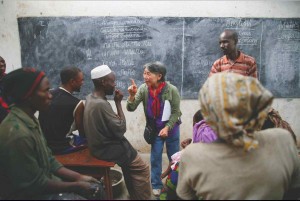
Other, darker personal material in the film includes the story of Yeh’s father. “My grandfather married twice and had two families,” said Traub. “When the communists took over he fled to Taiwan. Grandfather had a lot of guilt. He passed it on to her [Yeh].”
In a follow-up email, Traub expanded on that story, “My grandfather’s first wife and three children remained in Hainan Island throughout the war and after the second family fled to Taiwan. My grandfather essentially abandoned his first family. Later, he felt profound guilt about this. This guilt was passed down to my mother and she felt compelled to reconnect and make amends to the first family. This is one of the central strands of the film.”
Traub’s first photographic project, at age 12, was about his grandfather. “Those photos are in the film. They document his Altzheimer’s,” Traub said.
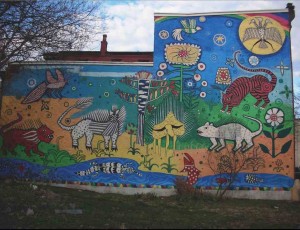
Yeh moved to Philadelphia from Taiwan in 1963 to study art at the University of Pennsylvania. She lives here still, although she spends time abroad working on her projects. Independent curator Judith Stein, who is a neighbor of Yeh’s in Center City and has known the artist almost 40 years, wrote a glowing tribute to Yeh’s Village of Arts and Humanities in 1993 for Metropolitan Home magazine. Calling Yeh “Part Huck Finn and part Wonder Woman,” Stein commented in particular on how Yeh “…gradually transformed neighborhood adults from skeptical bystanders to passionate participants in the twenty-some projects that now comprise the Village.”
“I liken her to Huck Finn because she has a way of doing things that makes people want to join in,” said Stein, who just delivered a 100,000 page manuscript to her publisher for the forthcoming biography of New York art dealer Richard Bellamy “The Eye of the Sixties.”
“When I knew her (40 years ago) she was doing beautiful watercolors, based in the Chinese tradition,” said Stein, adding that Yeh traded her a watercolor for a bicycle. Stein also mentioned that Yeh once co-taught a class with Camille Paglia at University of the Arts. “The thought of the two of them collaborating: Camille, the crusty intellectual, and Lily, the hands on social activist!” Stein said.
Lily Yeh’s story has been told in many news and magazine articles and books, including the book she authored about her Chinese project, Awakening Creativity: The Dandelion School Blossoms.” There is a film about her as well, Holsten’s 1999 Angel in the Village. But this new movie is a more intimate, focused look that shows the transformation of Yeh from local to global activist and deals with what motivates the artist’s humanist outreach. The core of the story is Yeh’s need to make families and communities rent asunder whole again.
The movie will be finished soon. “Our greatest hope is that the biggest film festival will take it,” said Holsten, half-joking. “I expect it will have a healthy festival life and a life in the art world and in academia. It’s about the cost of a life dedicated to public service.”
Traub and Holsten’s previous collaborative documentary project, OC87, about one man’s struggle with mental illness, debuted at the 2012 Philadelphia International Film Festival. They hope to debut The Barefoot Artist at the 2013 Philadelphia festival. See short clips from the movie here and a few more at Vimeo. And catch our podcast with Daniel Traub from 2011 here.
And because a movie takes a lot of money to put together, the two directors set up a fundraising campaign on USArtists to raise $60,000. Happily they were successful, but the campaign is still open and there are some lovely gifts for pledges, so by all means check it out and consider a contribution!



